{{currentView.title}}
April 21, 2023
Salafi-Jihadi Movement Weekly Update, April 19, 2023
To receive the Salafi-Jihadi Movement Weekly Update via email, please subscribe here. Follow CTP on Twitter, LinkedIn, and Facebook.
Data Cutoff: April 19, 2023, at 10 a.m.
Contributor: Sophie Small
Key Takeaways:
Global Movement. The Islamic State is strengthening and expanding globally. US operations targeting senior leaders in the Islamic State’s network temporarily disrupt the organization and its affiliates but fail to slow its expansion. The Islamic State is pursuing multiple military campaigns in Syria, where it takes advantage of poor counterinsurgency forces and rural sanctuary. The group is also strengthening in the Sahel, where it has effectively neutralized Malian army forces and al Qaeda–affiliated adversaries in northeastern Mali.[i] US Central Command assesses that the Islamic State affiliate in Afghanistan could conduct an attack targeting the West within six months, pointing to the inadequacy of US counterterrorism strategy in Afghanistan.[ii]
Iraq and Syria. ISIS is strengthening and expanding across Syria despite US raids targeting ISIS senior leadership. US raids eliminating senior leaders planning external attacks are good, but they are insufficient to defeat ISIS. The ISIS insurgency in central Syria is strengthening after successfully transitioning from defensive to offensive operations. ISIS is not a network of limited and ineffective sleeper cells, but rather a decentralized network of insurgents executing the early stages of a well-organized insurgency.
Sahel. Islamic State militants in the Sahel are strengthening their control over northeastern Mali. IS expansion in this area threatens US interests and personnel in neighboring Niger. IS core is likely using its global network to help its local affiliate appeal to civilians and set conditions to consolidate territorial control in northeastern Mali. Al Qaeda’s local affiliate, the Malian army, and Wagner Group are unlikely to undo IS’s gains in this area. The attempted coup in Sudan is also creating opportunities for the global Islamic State and al Qaeda networks to strengthen their influence in the region—and attack US personnel, in a worst-case scenario.
Pakistan. The Pakistani military is incorrectly defining the target of a nationwide military campaign against the Tehrik-e-Taliban Pakistan (TTP). Pakistan is overemphasizing the Afghan nationalities of TTP fighters to deflect blame and pressure the Afghan Taliban to target TTP sanctuaries in Afghanistan. Pakistan is unlikely to target these sanctuaries because Pakistani proxies are also located in some of these areas.
Afghanistan. The Taliban conducted operations to clear poppy fields in remote areas of eastern Afghanistan, which led to violent clashes that killed several local civilians. Islamic State Khorasan Province (ISKP) will likely exploit these operations to rebuild its traditional support bases in eastern Afghanistan. The Taliban continues to conduct poppy-clearing operations even though these operations risk increasing support for anti-Taliban groups.
Assessments:
Iraq and Syria.
ISIS is in the early stages of a well-organized insurgency in the central Syrian desert. Local leadership is executing the campaign while Islamic State global leadership provides guidance through central media office publications.[iii] This model creates a flexible organization that can exploit local opportunities but pursue ISIS’s strategic objectives defined by the so-called caliph.
ISIS likely completed a shift from latent, defensive insurgency to offensive guerrilla operations in February 2023.[iv] ISIS quadrupled attacks in the Syrian desert in February 2023 as compared to January 2023, and the group recorded its highest number of attacks since September 2021 in March 2023.[v] ISIS’s campaign in the central Syrian desert aims to protect its sanctuaries, neutralize anti-ISIS opposition, and suppress anti-ISIS forces to maintain ground lines of communication (GLOC) into other Syrian regions. ISIS cells block regime forces and pro-regime civilians from accessing rural areas where ISIS trains new recruits and supports operations.[vi] The group also targets local anti-ISIS sheikhs by kidnapping, ransoming, and executing family members.[vii] ISIS operations targeting tribes aim to neutralize opposition through intimidation.[viii] Finally, ISIS fighters suppress local anti-ISIS forces to maintain GLOCs to other regions, where the group can generate funds and concentrate forces for attacks.[ix]
Figure 1. ISIS Operations in Central Syria
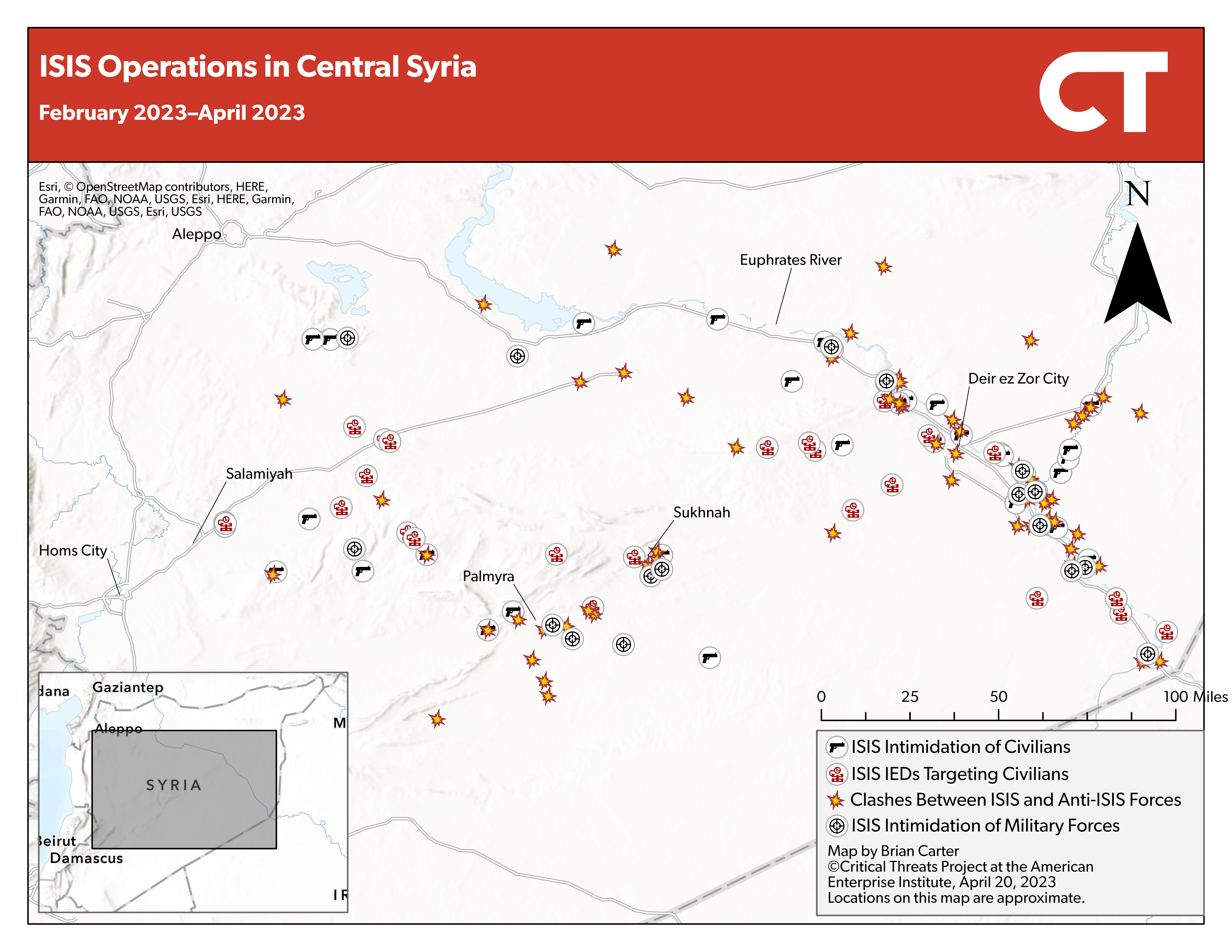
Note: Some of the locations on this map are approximate. CTP defines “intimidation” as executions, kidnapping, assassinations, and ISIS coercion of the population. CTP defines “clashes” as kinetic activity between ISIS and anti-ISIS forces, including improvised explosive devices, direct fire, complex attacks, and battles.
Source: Brian Carter.
This campaign is possible because ISIS set conditions for its return to offensive operations after regime-backed counter-ISIS operations in 2021 caused ISIS to decrease attacks and focus on protecting its forces.[x] ISIS only conducted 12 attacks per month on average between July 2021 and July 2022, after an average of 31 attacks per month between July 2020 and July 2021.[xi] A local journalist said that ISIS appointed an Iraqi citizen freed during the January 2022 prison break to lead ISIS in the central desert in mid-2022.[xii] Regime forces killed a previous leader in 2021.[xiii] The group continued small-scale attacks after 2021 to maintain desert sanctuaries to marshal resources and train new fighters.[xiv]
Some Western reporting incorrectly describes ISIS in the central Syrian desert as sleeper cells limited by counter-ISIS forces.[xv] The US-backed Syrian Democratic Forces (SDF), Iran-backed militias, and the Syrian regime face capacity constraints and capability limitations that render these forces unable to successfully defeat ISIS.[xvi] The SDF will very likely fail to contain ISIS without US support.[xvii] ISIS massacres are not isolated incidents; they instead aim to intimidate the population to gradually impose ISIS’s control over communities.
ISIS is also exploiting seams between disparate and opposed counter-ISIS forces to conduct mutually reinforcing campaigns across Syria.[xviii] ISIS efforts on both sides of the Euphrates permit the movement of cells across the river to support each other. ISIS desert sanctuaries allow the group to train new recruits and shelter veteran fighters, such as those freed from Al Sina’a prison in January 2022.[xix]
Figure 2. Coalition Operations Targeting ISIS Leaders in Northwestern Syria
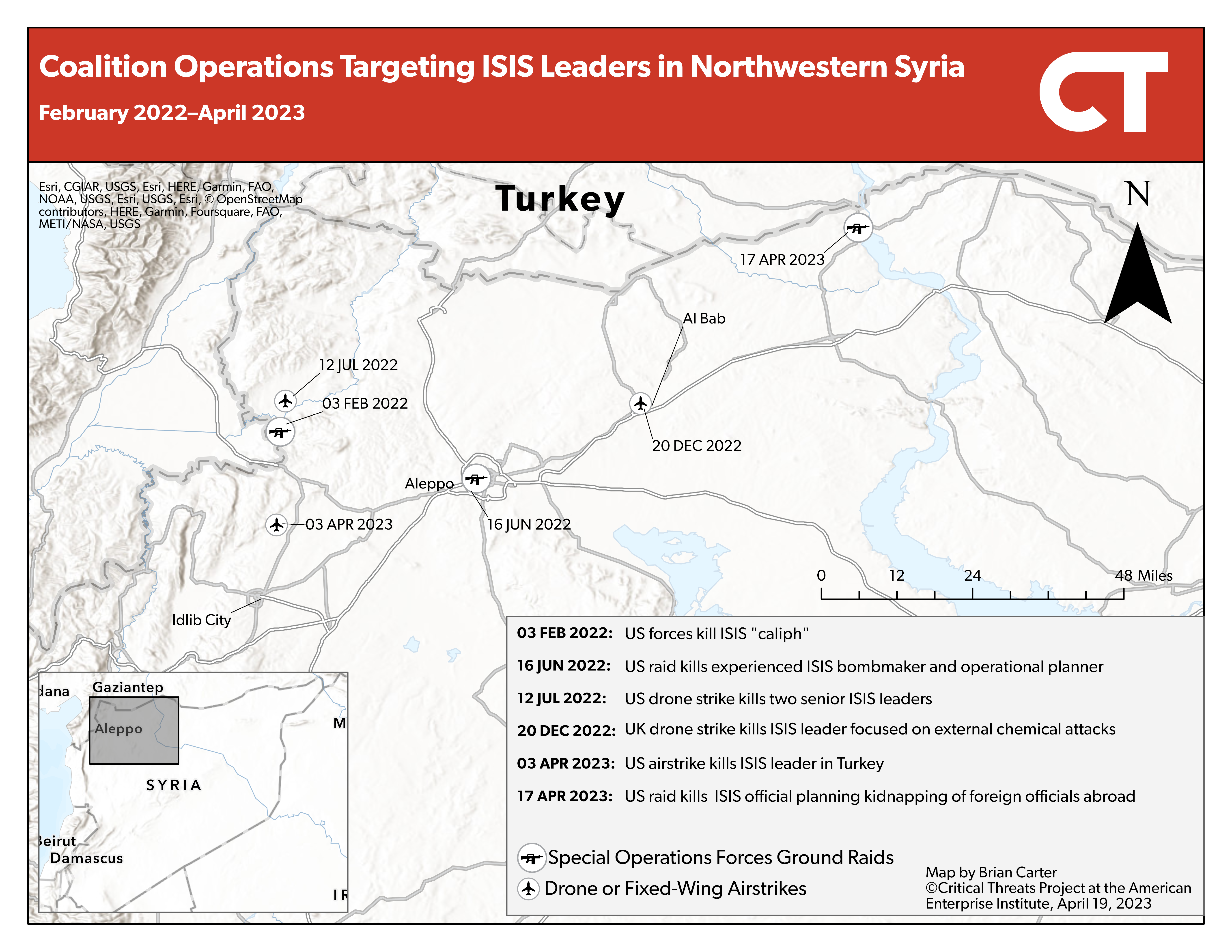
Source: Brian Carter.
Northwestern Syria. US special operations raids targeting ISIS senior leaders temporarily disrupt operations but are not sufficient to defeat the organization. A US special operations raid killed a senior ISIS official responsible for orchestrating external attacks on April 17 in Suwayda, near Jarabulus, Aleppo province, Syria.[xx] The official was reportedly planning to kidnap officials abroad as leverage for ISIS.[xxi] This raid is the latest in a string of raids in northwestern Syria, including a raid targeting the ISIS leader in Turkey in northwestern Syria on April 3.[xxii] ISIS is continuing to expand and strengthen across Syria despite these raids, pointing to the insufficiency of raids to defeat ISIS’s insurgency.
Northwestern Syria will remain permissive for ISIS and a key sanctuary for ISIS senior leaders despite US special operations raids. Turkish-backed factions are not reliable counterterrorism partners. A Turkish-backed faction controls Suwayda, but the faction denied knowledge of the ISIS leader’s identity.[xxiii] Some Turkish-backed factions—though not the force occupying Suwayda—harbor ISIS fighters and commanders, whom the factions see as more effective fighters.[xxiv] ISIS leaders in northwestern Syria also take advantage of internally displaced persons flows into northwestern Syria to disguise themselves.[xxv]
Figure 3. The Salafi-Jihadi Movement in the Middle East
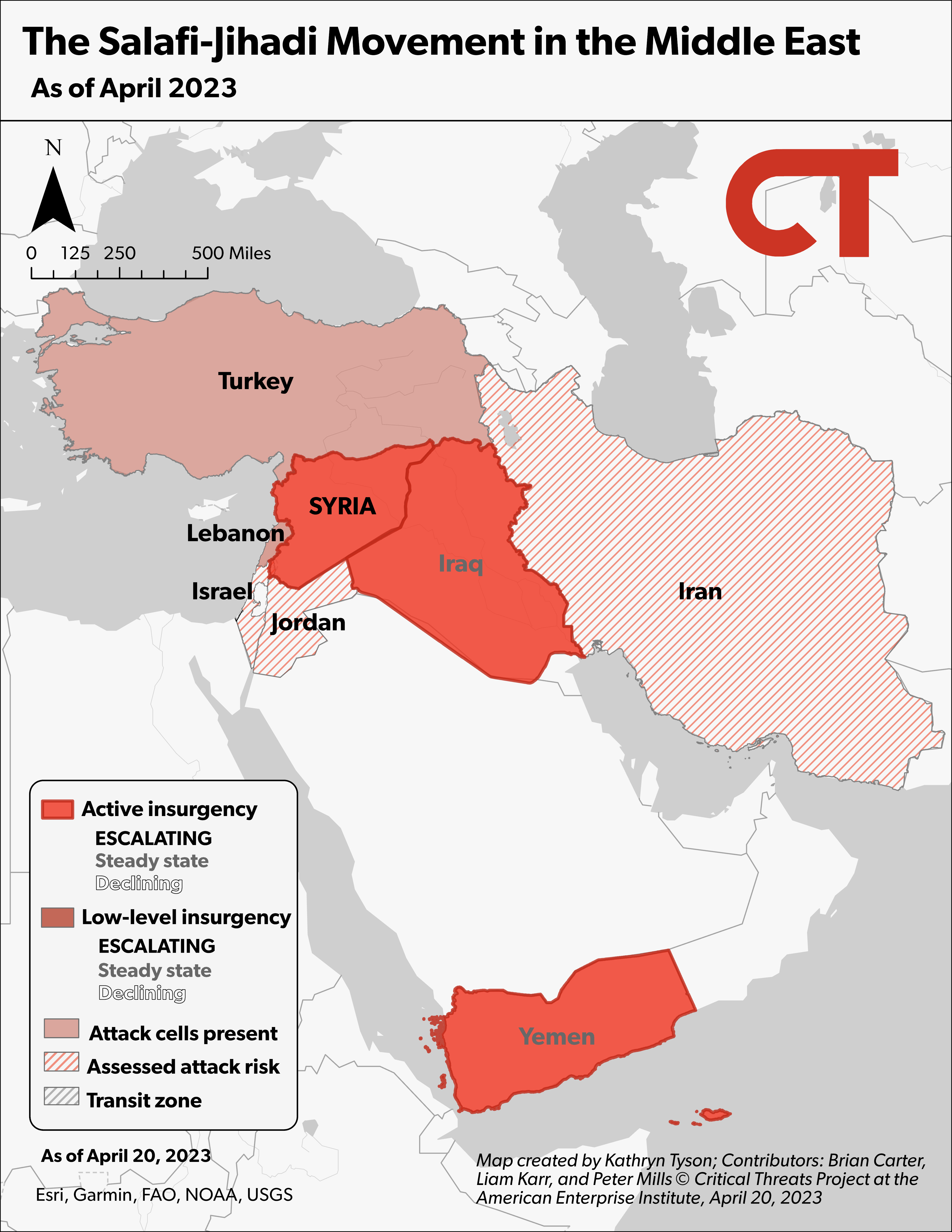
Source: Kathryn Tyson.
Sahel.
The Islamic State in the Greater Sahara (ISGS) is strengthening its control over northeastern Mali. ISGS took control of a district capital on April 10, completing the encirclement of Mali’s easternmost regional capital, Menaka.[xxvi] A France24 journalist said that militants distributed propaganda pamphlets outlining the Islamic State’s mission to help win support among locals.[xxvii] Previous ISGS efforts in northeastern Mali sought to coerce the population through massacres.[xxviii] ISGS has been waging an offensive in the region since France began drawing down its forces in Mali in early 2022.[xxix]
Figure 4. ISGS Expands in the Menaka Region
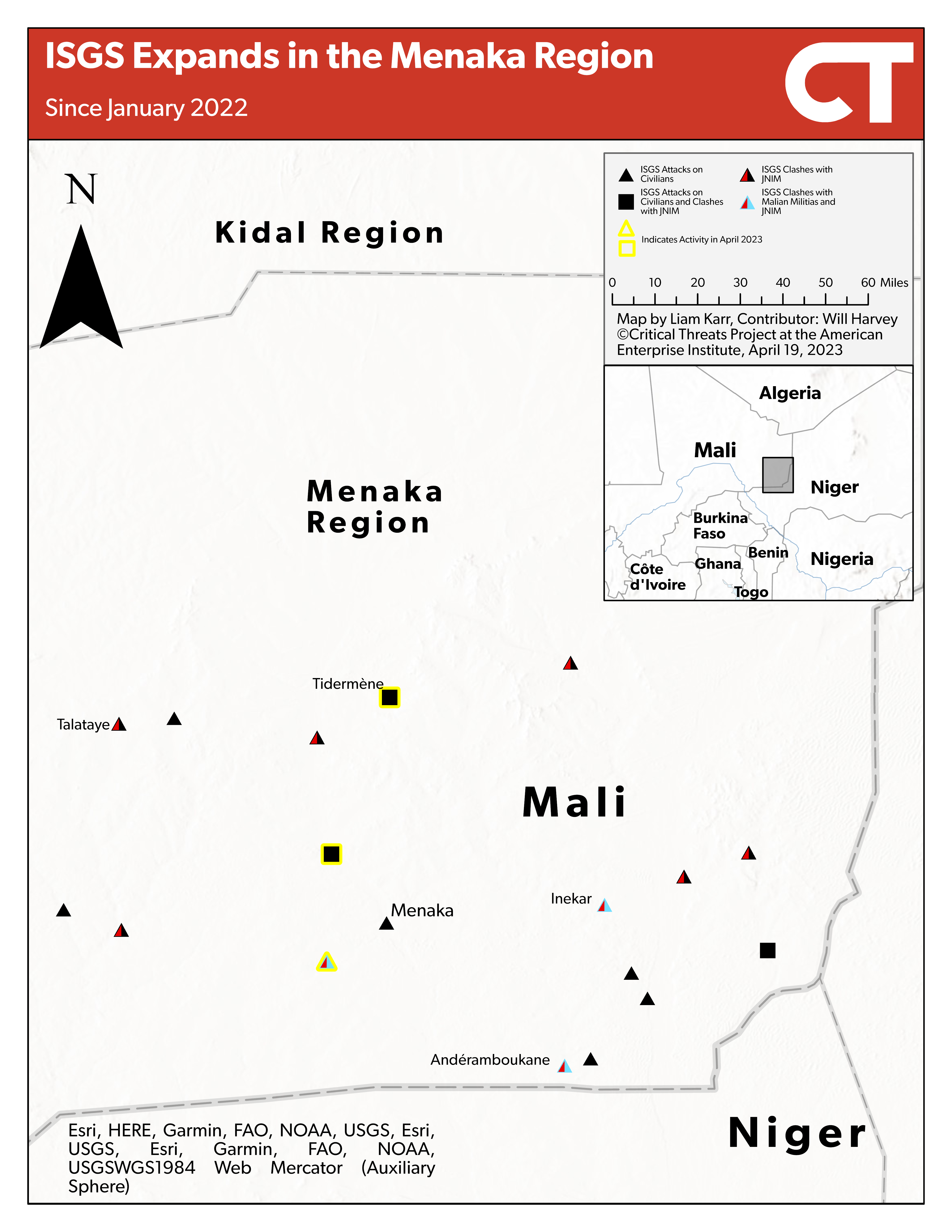
Source: Liam Karr.
ISGS’s use of new support zones in northeastern Mali will allow it to increase the rate and severity of its attacks in the Nigerien-Malian-Burkinabe tri-border region, undermining US and Western interests. Niger is the last reliable Western counterterrorism partner in the tri-border area after Western relationships with the Malian and Burkinabe juntas deteriorated.[xxx] Western-supported Nigerien counterterrorism efforts aimed at degrading ISGS’s sanctuaries along Niger’s western borders have not been successful, despite isolated tactical achievements, because of a lack of supporting pressure on the Burkinabe and Malian sides of the border.[xxxi] ISGS and IS’s West Africa Province (ISWAP) in the Lake Chad Basin are increasing their rate of attacks on opposite sides of the country in spring 2023.[xxxii] This will impose resource constraints on the Nigerien military as it responds to these attacks.
Growing instability in Niger could also undermine faith in Western support and create opportunities for Russia to increase its influence in the country. An increase in anti-Western sentiment among Nigerien citizens could lead to a coup or an anti-Western government that seeks a partnership with Russia as an alternative partner, as Mali and Burkina Faso have experienced.[xxxiii] Niger recently thwarted a coup attempt in March 2021.[xxxiv] Russia could exploit new deals to access Niger’s uranium deposits to aid Russia’s sanctions-evasion efforts.[xxxv] Russia has increased its presence in other African states to evade sanctions by exploiting resources and to undermine Western influence.[xxxvi] Niger did sign a military deal to purchase helicopters from Russia in 2019 but has not developed stronger ties since, likely due to its strong partnership with the West.[xxxvii]
Figure 5. ISGS Expands in the Tri-Border Region
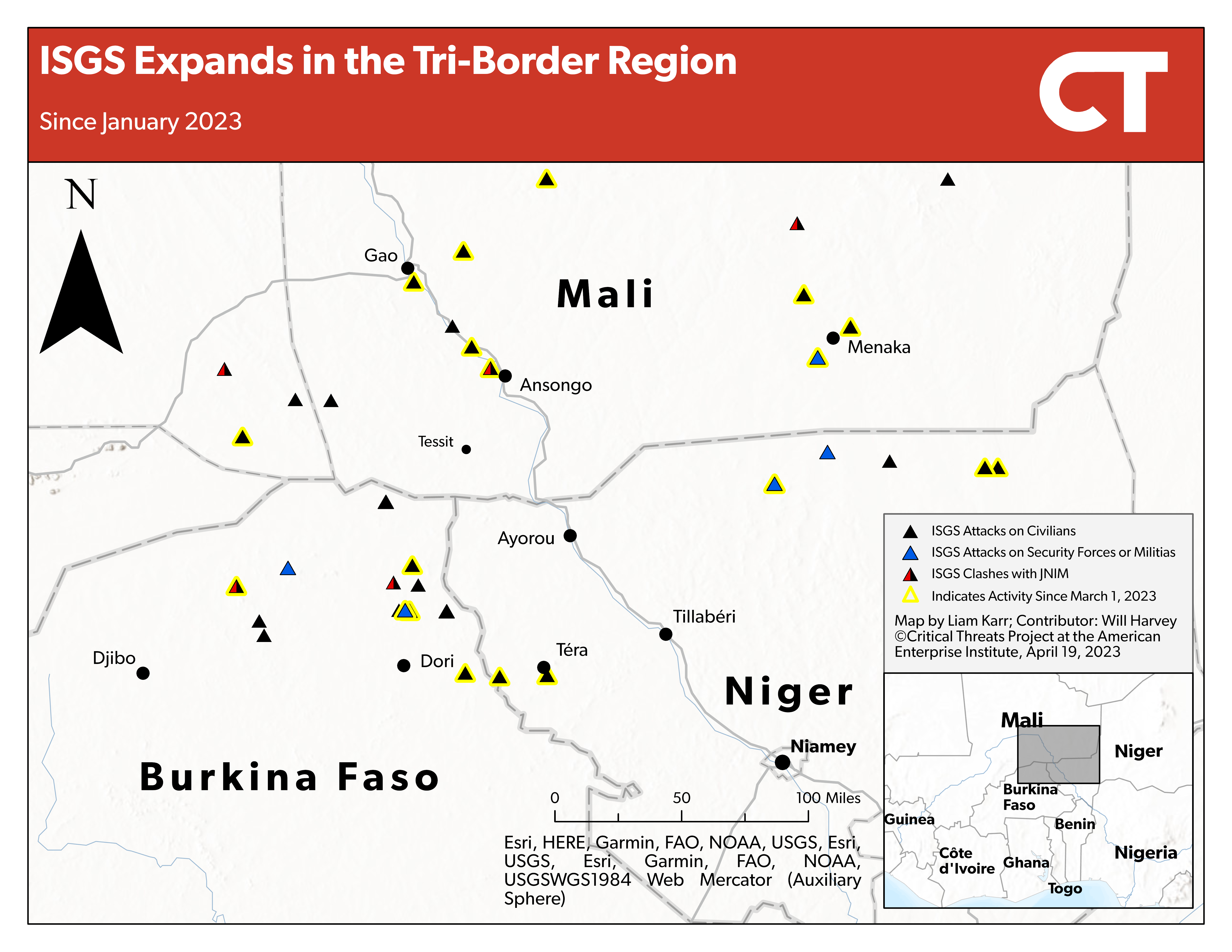
Source: Liam Karr.
Figure 6. ISWAP Attacks in Niger
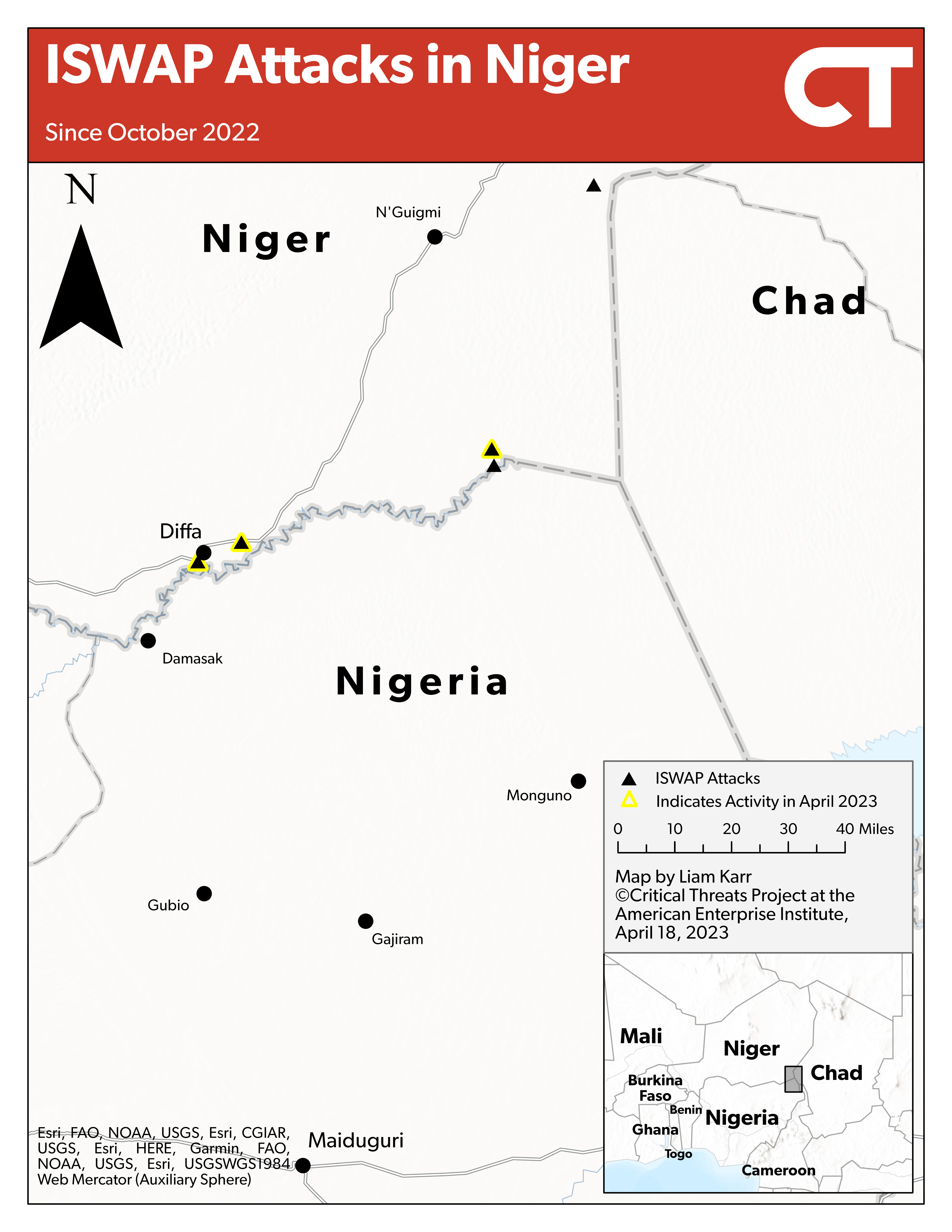
Source: Liam Karr.
New ISGS support zones in northeastern Mali will also help ISGS strengthen lines of communication with ISWAP, which could threaten US personnel in the Sahel. ISGS and ISWAP have already maintained lines of communication via smuggling routes that run through West Africa for several years.[xxxviii] The two groups have also shown the capability and intent to target US personnel. ISGS ambushed and killed four US service members in western Niger in 2017 and have carried out attacks within three miles of the capital, and ISWAP was behind a credible threat that led to the evacuation of nonessential personnel and family from the US embassy in Abuja in October 2022.[xxxix] Strengthened lines of communication between ISWAP and ISGS will enable the pooling of organizational resources to plot similar attacks in Niger.
ISWAP or the IS core may be encouraging ISGS to soften its approach toward locals to build greater local support. ISWAP heads the regional IS administrative office and may have sent advisors to ISGS to guide this shift.[xl] ISGS militants only carried out targeted killings instead of massacring the entire village when it entered the district capital on April 10.[xli] They also distributed mission-statement pamphlets around the area that are copies of letters ISIS distributed in Syria in 2014.[xlii] ISGS militants are still ransacking villages and have not adopted this approach across its area of operations.[xliii] This discrepancy indicates that rank-and-file ISGS militants could inhibit this change.
The Malian army, Wagner Group, and UN forces are unlikely to undo ISGS’s gains in the coming months. Malian army, Wagner Group, and United Nations forces stationed in Menaka rarely leave their bases, despite ISGS attacks targeting villages within 10 miles of Menaka.[xliv] The Malian government does not prioritize northern Mali, making it unlikely to provide additional support to its forces in northern Mali to enable offensive operations.[xlv] The Malian army and Wagner Group are also unable to significantly reinforce their troops because their base lacks an airstrip, which would be a requirement in the unlikely event of a counteroffensive.[xlvi]
Al Qaeda affiliate Jama’at Nusrat al Islam wa al Muslimeen (JNIM) is also unlikely to roll back ISGS. JNIM and local militias attempted to resist the ISGS offensive throughout 2022, but ISGS has continued to expand.[xlvii] ISGS’s rapid expansion since France’s withdrawal underscores how crucial French air strikes and other operations were to containing ISGS.[xlviii]
However, JNIM’s strongholds and connections with the Tuareg ethnic group will serve as a buffer to further ISGS advances north into the Kidal region.[xlix] JNIM possesses more fighters and money across the Sahel than does ISGS.[l] The group’s emir and other leadership is from Kidal, and JNIM will leverage its local relationships to defend the region.[li] The Tuareg are the main ethnic base for the JNIM subgroup in the area and its militia partners, making the human terrain in the area unfavorable to ISGS, which recruits from primarily Fulani populations along the border.[lii] Tuareg populations are also opposed to ISGS due to ISGS’s massacres of Tuareg civilians in the Menaka region.[liii]
ISGS, with support from IS’s global network, will likely set conditions to impose territorial control in northeastern Mali to achieve IS’s global objective of a territorial “caliphate.” ISGS is capable of launching large-scale complex attacks to overrun the remaining military bases in Menaka town.[liv] However, it is unable to hold territory because it recruits or coerces many of its fighters from surrounding areas, and the fighters return to their villages after attacking a given target.[lv] IS can channel support through its global network to mitigate this drawback and help ISGS set conditions to hold territory. ISGS requires more full-time fighters to effectively hold territory and administrative structures to govern, given it has only provided governance activity on an ad hoc and small-scale basis.[lvi] ISGS will likely continue besieging Menaka as it sets conditions to establish territorial control.[lvii] ISGS besieges population centers while controlling rural areas throughout the tri-border region.[lviii]
ISGS’s and JNIM’s campaigns are destabilizing West Africa, to the detriment of US interests. JNIM has sustained attacks around Mali’s capital in 2023 and is also rapidly gaining ground in Burkina Faso.[lix] Both groups are using the permissive environment in Burkina Faso to make inroads in countries along the Gulf of Guinea.[lx] This expansion challenges US and allied efforts to stabilize the region through efforts such as the Global Fragility Act.[lxi] Littoral expansion also presents another opportunity for the groups to strengthen lines of communication with ISGS and JNIM’s Nigerian-based allies.[lxii]
Sudan. The paramilitary Rapid Support Forces (RSF) launched a coup against their governing partners, the Sudanese army, on April 15, causing major fighting across the country that has killed at least 185 people.[lxiii] The relationship between the two governing partners had been deteriorating since at least December 2022, after disagreements over how to integrate the RSF into the Sudanese military.[lxiv]
Al Qaeda or the Islamic State’s global network could take advantage of instability the Sudanese coup has caused. The emerging crisis in Sudan shares similarities with other crises in Africa that Salafi-jihadi groups used to strengthen themselves. Al Qaeda created a Libyan-based affiliate during the 2011 Libyan revolution that eventually carried out the 2012 Benghazi attack.[lxv] ISIS sent envoys to Libya in 2013 and returning Libyan fighters in Syria to Libya through preexisting transnational crime and al Qaeda in Iraq networks.[lxvi]
Salafi-jihadi militants could use existing networks to target Western personnel in a worst-case scenario. CTP has not observed indications that Salafi-jihadi militants have attack capabilities in Sudan. However, Salafi-jihadi militants are already present in the transnational trafficking routes in the country and have historical roots in Sudan dating back to the Bashir era.[lxvii] These militants could take advantage of the instability and reactivate former networks to operationalize their presence. Unknown forces attacked a US convoy in Sudan on April 18 and assaulted an EU ambassador on April 17.[lxviii] There is no evidence that a Salafi-jihadi group conducted these attacks.
Figure 7. The Salafi-Jihadi Movement in Africa
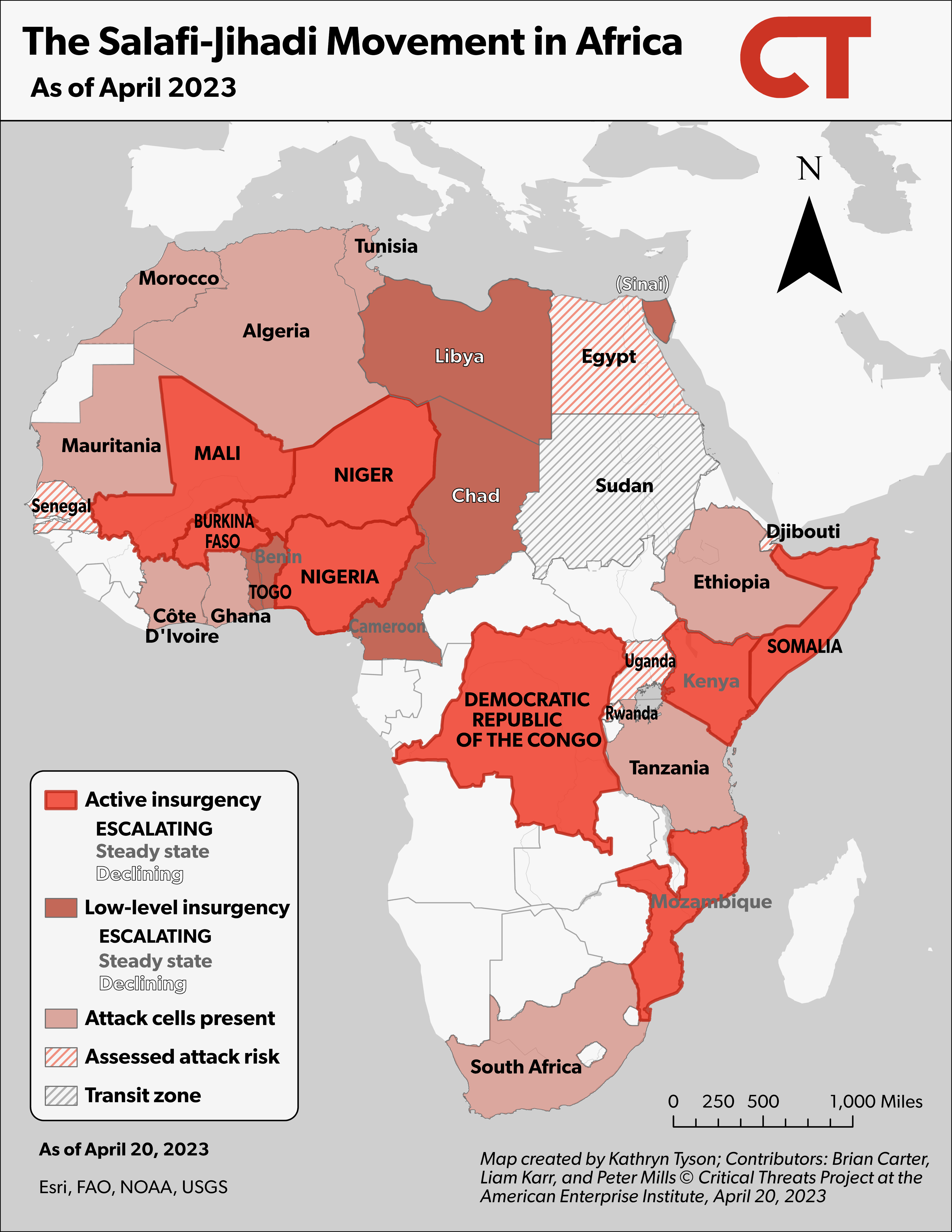
Source: Kathryn Tyson.
Pakistan.
Pakistani political and military leadership announced a nationwide counter- Tehrik-e-Taliban Pakistan (TTP) campaign on April 7 that does not accurately define the target. [lxix] Pakistani security forces distributed leaflets on April 7 saying Pakistan would specifically target Afghan nationals in North and South Waziristan in its military campaign.[lxx] The TTP does not believe in a formal Pakistani state, meaning TTP militants identify with Pashtun tribal identity over Pakistani or Afghan nationalities. Pakistan is also deflecting blame for the TTP threat onto the Afghan Taliban. Pakistani security forces have repeatedly highlighted that TTP militants from or based in Afghanistan were involved in recent high-profile TTP attacks.[lxxi] Their claims refer to the expanded scope of TTP attacks across Pakistan since ending a cease-fire with the Pakistani government in November 2022.[lxxii]
Pakistan is attempting to pressure the Taliban government to curtail the further expansion of TTP attacks. The Pakistani defense minister warned the Taliban on April 12 that Pakistan would target TTP safe havens in Afghanistan if the Taliban did not rein in the group. Pakistan previously targeted the TTP along the Durand Line between 2007 and 2009 and in 2014, when US and coalition forces helped contain the TTP to a narrow border strip.[lxxiii]
Figure 8. TTP Attacks and Pakistani Operations Against the TTP
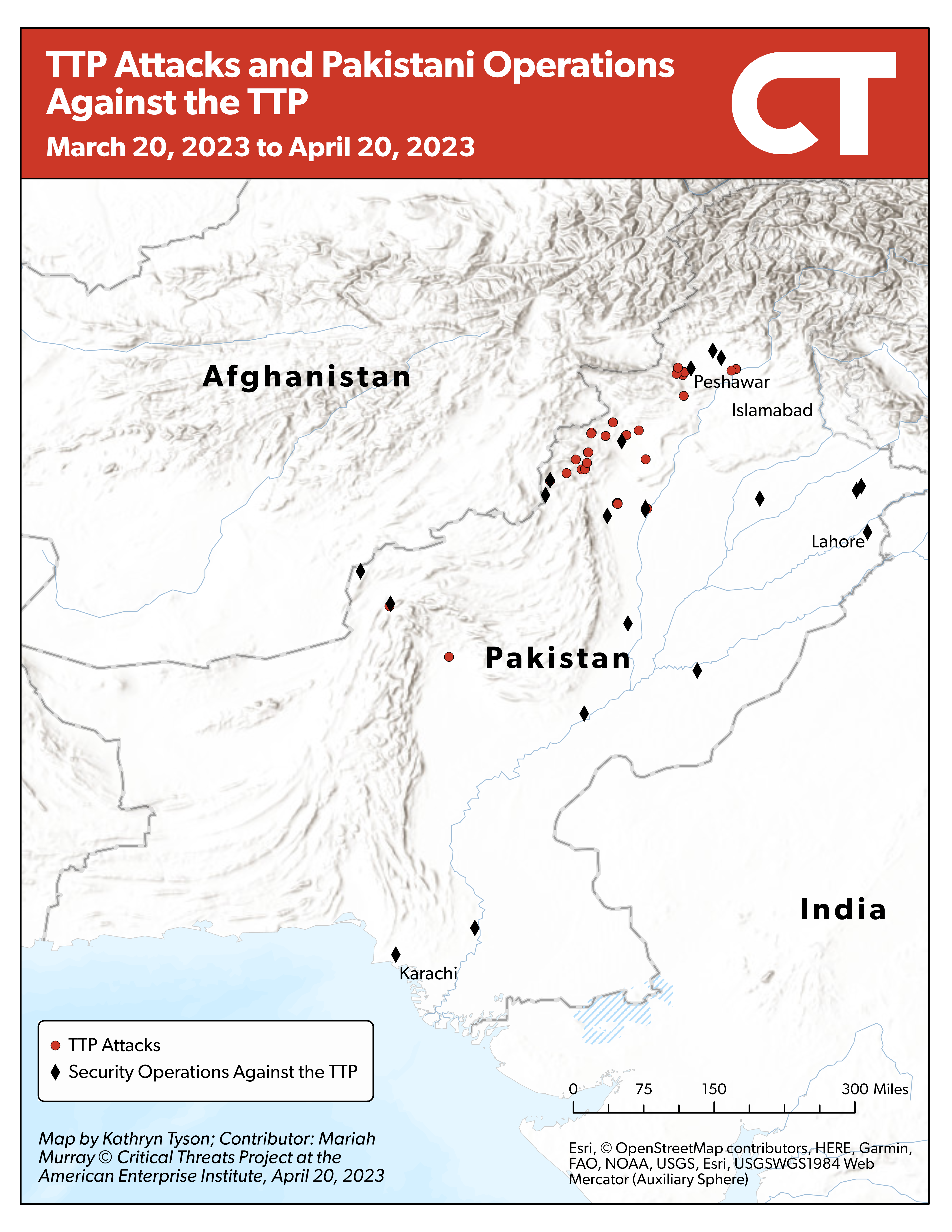
Source: Kathryn Tyson.
Pakistan is unlikely to strike in Afghanistan because it is geographically restricted, maintains proxies in areas in Afghanistan with TTP safe havens, and seeks to avoid a broader conflict with the Taliban. The TTP has sanctuaries deeper in Afghanistan in areas where Pakistani proxies are also located. Pakistan analysts cited local sources as saying that an explosion killed six members of the TTP’s Hafiz Gul Bahadur group in Khost City, Afghanistan—20 miles west of the Afghanistan-Pakistan border—on March 1, although the TTP never confirmed the explosion killed its militants, and some pro-TTP accounts denied reporting of TTP casualties.[lxxiv] Khost’s location deeper in Afghanistan means targeted strikes against the TTP will be less likely to kill TTP militants. Pakistan carried out air strikes in Khost province in April 2022, but the strikes killed dozens of civilians and damaged relations between Pakistan and the Taliban government.[lxxv] Khost has also historically served as a base for the Haqqani Network, a branch of the Afghan Taliban that has acted as a proxy for the Pakistani state and mediated talks between Pakistan and the TTP in 2022.[lxxvi] The Hafiz Gul Bahadur group also has ties to the Haqqanis.[lxxvii] Pakistan’s close relationship with the Haqqanis means it would likely go out of its way to avoid striking Haqqani areas.
Pakistani strikes in Afghanistan could risk a broader conflict with the Taliban. To avoid such a conflict, Pakistan will likely try to engage with the Taliban in talks before carrying out a broader counter-TTP campaign. Pakistan sent its ambassador back to Kabul, Afghanistan, on April 16, after the Pakistani and Afghan foreign ministers discussed “areas of mutual interest,” which may have included approaches to the TTP.[lxxviii] Pakistan will also need to coordinate with the Taliban on securing the Afghanistan-Pakistan border to avoid TTP militants retreating into Afghanistan and rebuilding unhindered.
Afghanistan.
Islamic State Khorasan Province (ISKP) will likely exploit Taliban abuses and misgovernance to reestablish its traditional strongholds in eastern Afghanistan. Taliban operations eradicating opium poppy fields in Achin, Nangarhar Province, on April 10 led to violent clashes with locals that killed several civilians.[lxxix] Anti-Taliban social media accounts claim local civilians killed several Taliban fighters in a second clash.[lxxx] Poppy fields remain crucial for many Afghans’ livelihoods.[lxxxi] ISKP previously controlled Achin district until late 2019, when combined operations by Afghan National Army and US Special Operations cleared the area.[lxxxii] ISKP continues to operate in the district and conducted multiple attacks on local Taliban commanders in October and November 2022.[lxxxiii] Taliban security forces discovered a cache of ISKP improvised explosive devices in Achin on March 23.[lxxxiv]
The Taliban government realizes the risk that poppy eradication policies will increase support for ISKP, but it is unwilling or unable to change its policies. Taliban provincial leaders met with local elders in Achin District on April 11 and apologized for killing civilians.[lxxxv] However, the Taliban officials reiterated that the local people had an obligation to follow the Taliban supreme leader and warned locals against working with “saboteurs,” a reference to ISKP.[lxxxvi] The Taliban Interior Ministry proceeded with further poppy-field-clearance operations in remote areas of Laghman, Kunar, and Sar-I Pul Provinces, including areas where ISKP and other anti-Taliban groups operate, on April 18.[lxxxvii]
Taliban Military Capabilities. The Taliban chief of army staff said the Taliban government wanted to secure air defense weapons to prevent drones from entering Afghanistan in an interview on April 12.[lxxxviii] The Taliban movement began expressing a desire to prevent foreign drones from entering Afghan airspace on August 28, after the US drone strike that killed al Qaeda leader Ayman al Zawahiri.[lxxxix] The chief of army staff framed his comments around protecting Afghan airspace from all foreign drones without identifying a specific country. He also did not specify the type or source of air defense systems the movement seeks to acquire. Taliban air defense systems would exacerbate the well-documented challenges of an over-the-horizon counterterrorism strategy by making Afghan airspace less permissive for US drones.[xc]
Figure 9. The Salafi-Jihadi Movement in Central and South Asia
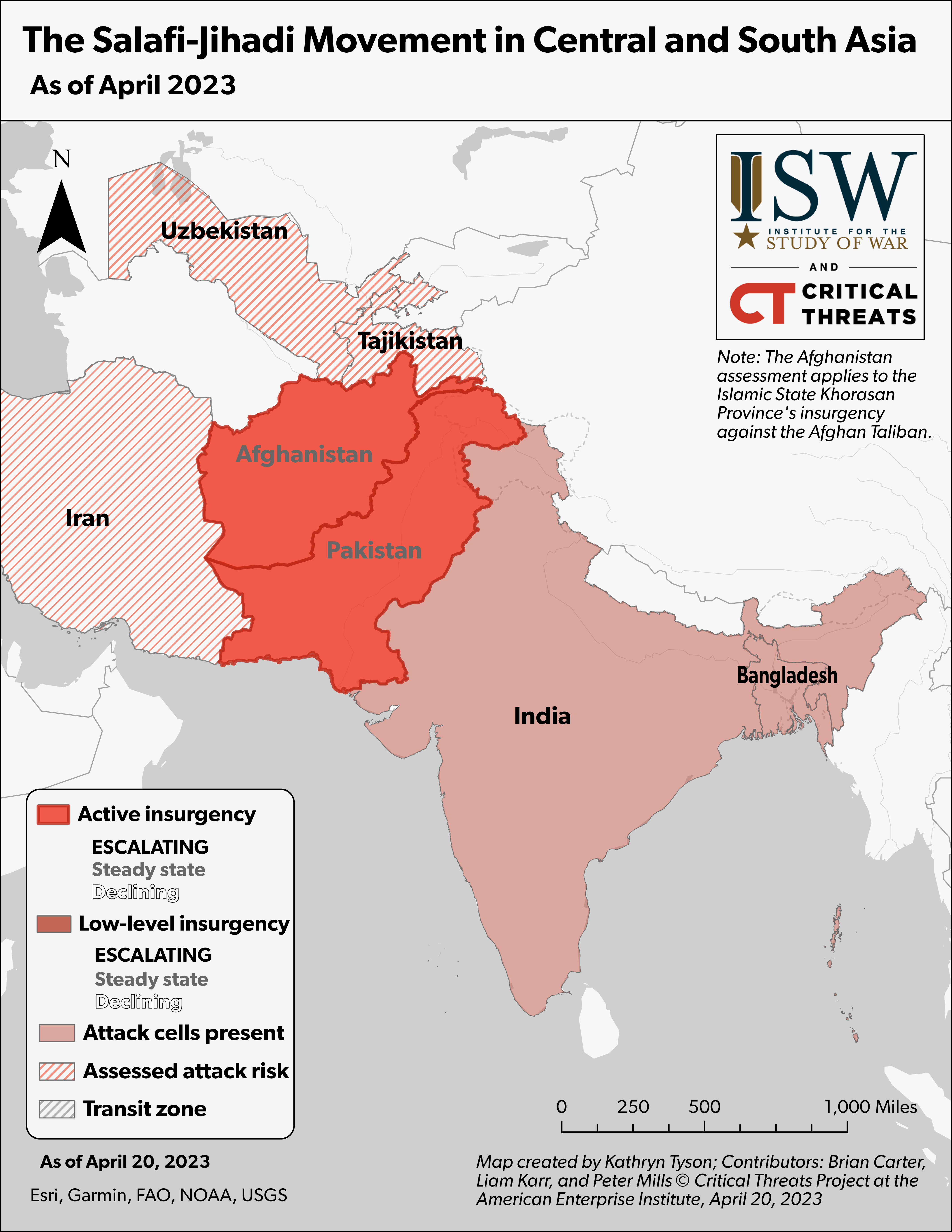
Source: Kathryn Tyson.
[i] The US Army defines “neutralize” as “a tactical mission task that results in rendering enemy personnel or materiel incapable of interfering with a particular operation” for a time or event-bound duration. See page 260: https://armypubs.army.mil/epubs/DR_pubs/DR_a/NOCASE-FM_3-90-1-002-WEB-6.pdf
[ii] https://www.centcom.mil/MEDIA/Transcripts/Article/3340646/house-armed-services-committee-hearing-us-military-posture-and-national-securit; https://www.criticalthreats.org/analysis/salafi-jihadi-movement-weekly-update-april-5-2023
[iii] https://www.criticalthreats.org/analysis/salafi-jihadi-movement-weekly-update-april-12-2023
[iv] US Army FM 3-24 Insurgencies and Countering Insurgencies defines a “latent and incipient insurgency” as a period in which “the emergence of insurgent leadership, the creation of initial organization infrastructure, training, acquisition of resources, [and] political actions” occur. A “guerrilla warfare” phase is defined as the use of “small unit tactics to attack security forces while continuing ongoing political efforts.” See page 64: https://armypubs.army.mil/epubs/DR_pubs/DR_a/pdf/web/fm3_24.pdf
[v] Author’s research; https://www.google.com/maps/d/u/0/viewer?mid=1VubVoZdI1rnqMlfAkmBECat-mpWZOEIA&ll=35.02433881466235%2C38.97583643085943&z=9; https://www.counterextremism.com/content/unsolved-murders-syrias-badia-truffle-hunters-crosshairs-and-isis-large
[vi] https://kyleorton.co.uk/2022/09/01/al-naba-349-interview-islamic-state-insurgency-badiya-desert
[vii] https://www.counterextremism.com/content/unsolved-murders-syrias-badia-truffle-hunters-crosshairs-and-isis-large
[viii] https://www.criticalthreats.org/analysis/salafi-jihadi-movement-weekly-update-march-22-2023
[ix] https://jihadology.net/wp-content/uploads/_pda/2023/04/The-Islamic-State-al-Naba%CC%84-Newsletter-386.pdf; https://www.criticalthreats.org/analysis/salafi-jihadi-movement-weekly-update-march-8-2023; https://www.counterextremism.com/content/unsolved-murders-syrias-badia-truffle-hunters-crosshairs-and-isis-large
[x] https://www.counterextremism.com/content/unsolved-murders-syrias-badia-truffle-hunters-crosshairs-and-isis-large
[xi] https://www.counterextremism.com/content/unsolved-murders-syrias-badia-truffle-hunters-crosshairs-and-isis-large
[xii] https://twitter.com/DeirEzzore/status/1590710469261950979?s=20
[xiii] https://www.counterextremism.com/content/unsolved-murders-syrias-badia-truffle-hunters-crosshairs-and-isis-large
[xiv] https://kyleorton.co.uk/2022/09/01/al-naba-349-interview-islamic-state-insurgency-badiya-desert
[xv] https://apnews.com/article/politics-syria-government-iraq-beirut-24b8cc5c050156457b1166503aa9ef36; https://apnews.com/article/syria-hama-truffle-hunters-attack-islamic-state-752d3df78b308c469d8515e13c04337c; https://www.nytimes.com/2023/04/10/world/middleeast/syria-truffles-war.html?smid=tw-share
[xvi] https://www.criticalthreats.org/analysis/salafi-jihadi-movement-weekly-update-april-12-2023; https://www.criticalthreats.org/analysis/ending-the-us-presence-in-syria-could-cause-a-rapid-isis-reconstitution-and-threaten-core-us-national-security-interests; https://www.criticalthreats.org/analysis/isis-will-leverage-improved-attack-capabilities-to-generate-forces-in-syria
[xvii] https://www.criticalthreats.org/analysis/ending-the-us-presence-in-syria-could-cause-a-rapid-isis-reconstitution-and-threaten-core-us-national-security-interests; https://www.criticalthreats.org/analysis/isis-will-leverage-improved-attack-capabilities-to-generate-forces-in-syria
[xviii] https://www.criticalthreats.org/analysis/salafi-jihadi-movement-weekly-update-march-29-2023
[xix] https://www.mei.edu/publications/closer-look-isis-attack-syrias-al-sina-prison; https://www.voanews.com/a/middle-east_islamic-state-group-smuggling-boys-desert-training-camps/6209124.html
[xx] https://twitter.com/CENTCOM/status/1647854519332610050?s=20
[xxi] https://twitter.com/CENTCOM/status/1648037123646267393?s=20
[xxii] https://www.criticalthreats.org/analysis/salafi-jihadi-movement-weekly-update-april-5-2023
[xxiii] https://twitter.com/Interactivepla2/status/1647772953730228225?s=20
[xxiv] https://rojavainformationcenter dot com/2022/07/the-syrian-national-army-the-turkish-proxy-militias-of-northern-syria
[xxv] https://www.crisisgroup.org/middle-east-north-africa/east-mediterranean-mena/syria/239-containing-transnational-jihadists-syrias
[xxvi] https://www.rfi.fr/fr/afrique/20230411-mali-le-groupe-%C3%A9tat-islamique-prend-tiderm%C3%A8ne-m%C3%A9naka-en-sursis
[xxvii] https://twitter.com/SimNasr/status/1645760130548473856?s=20
[xxviii] https://www.hrw.org/news/2022/10/27/mali-coordinated-massacres-islamist-armed-groups
[xxix] https://www.jeuneafrique.com/1436245/politique/mali-a-menaka-la-vie-sous-la-pression-de-letat-islamique; https://www.criticalthreats.org/analysis/salafi-jihadi-movement-weekly-update-march-16-2023
[xxx] https://www.criticalthreats.org/analysis/salafi-jihadi-movement-weekly-update-february-8-2023; https://www.reuters.com/world/africa/burkina-faso-confirms-end-military-accord-with-france-2023-01-23; https://www.reuters.com/world/german-government-plans-deploy-troops-niger-part-eu-mission-2023-03-29
[xxxi] https://www.france24.com/en/tv-shows/focus/20230412-niger-france-military-cooperation-an-inside-look-at-operation-almahaou
[xxxii] Author’s research.
[xxxiii] https://www.thenewhumanitarian.org/news-feature/2023/02/28/why-niger-protest-france-anti-jihadist-campaign-interviews; https://www.reuters.com/world/europe/french-convoy-faces-new-protests-after-crossing-into-niger-burkina-faso-2021-11-27; https://www.criticalthreats.org/briefs/africa-file/africa-file-burkina-faso-coup-signals-deepening-governance-and-security-crisis-in-the-sahel; https://www.criticalthreats.org/briefs/africa-file/africa-file-wagner-group-in-burkina-faso-will-help-the-kremlin-and-hurt-counterterrorism; https://www.criticalthreats.org/briefs/africa-file/africa-file-wagner-group-deployment-to-mali-threatens-counterterrorism-efforts
[xxxiv] https://www.bbc.com/news/world-africa-56589168
[xxxv] https://world-nuclear.org/information-library/country-profiles/countries-g-n/niger.aspx
[xxxvi] https://time.com/6165246/putin-africa-evade-sanctions
[xxxvii] https://www.reuters.com/article/us-russia-africa-niger-helicopters/russia-signs-deal-to-supply-nigeria-with-12-attack-helicopters-ria-idUSKBN1X220T
[xxxviii] https://digitallibrary.un.org/record/3874983?ln=en
[xxxix] https://www.cnn.com/2017/10/24/politics/niger-ambush-timeline/index.html; https://www.gov.uk/foreign-travel-advice/niger/terrorism; https://www.criticalthreats.org/briefs/africa-file/africa-file-islamic-state-affiliate-attempts-to-assassinate-nigerian-president; https://www.hudson.org/sahelian-or-littoral-crisis-examining-widening-nigerias-boko-haram-conflict; https://ng.usembassy.gov/security-notice-authorized-departure-status; https://ng.usembassy.gov/security-alert
[xl] https://twitter.com/ZagazOlaMakama/status/1627672724834336769?s=20; https://www.securitycouncilreport.org/atf/cf/%7B65BFCF9B-6D27-4E9C-8CD3-CF6E4FF96FF9%7D/S%202022%20547.pdf
[xli] https://www.criticalthreats.org/analysis/salafi-jihadi-movement-weekly-update-march-16-2023
[xlii] https://twitter.com/SimNasr/status/1645813091186221057?s=20
[xliii] https://www.dw.com/fr/mali-menaka-etat-islamique-au-grand-sahara/a-65283334; https://www.cnn.com/2023/04/09/africa/burkina-faso-civilians-killed-intl
[xliv] https://www.jeuneafrique.com/1436245/politique/mali-a-menaka-la-vie-sous-la-pression-de-letat-islamique; https://twitter.com/ocisse691/status/1647177980450422787?s=20; https://twitter.com/Walid_Leberbere/status/1646568737397506065?s=20
[xlv] https://www.criticalthreats.org/briefs/africa-file/africa-file-al-qaeda-linked-militants-take-control-in-northern-mali; https://www.criticalthreats.org/briefs/africa-file/africa-file-rapid-french-withdrawal-unravels-counterterrorism-posture-in-mali
[xlvi] https://www.bing.com/maps?FORM=Z9LH2&cp=15.927525%7E2.383786&lvl=18.0&style=a
[xlvii] https://www.criticalthreats.org/analysis/salafi-jihadi-movement-weekly-update-march-16-2023; https://www.youtube.com/watch?v=6tAsO5QddCo
[xlviii] https://www.criticalthreats.org/analysis/salafi-jihadi-movement-weekly-update-march-16-2023; https://www.criticalthreats.org/briefs/africa-file/africa-file-al-qaeda-linked-militants-take-control-in-northern-mali
[xlix] https://ecfr.eu/special/sahel_mapping/ansar_al_din; https://crisis24.garda.com/alerts/2022/09/mali-coalition-of-armed-tuareg-groups-conducting-indefinite-security-operation-in-kidal-as-of-sept-27
[l] https://eeradicalization.com/jihadist-competition-and-cooperation-in-west-africa; https://acleddata.com/2023/01/13/actor-profile-the-islamic-state-sahel-province; https://issafrica.org/iss-today/abductions-the-hidden-face-of-malis-crisis
[li] https://africacenter.org/publication/puzzle-jnim-militant-islamist-groups-sahel
[lii] https://www.criticalthreats.org/briefs/africa-file/africa-file-al-qaeda-linked-militants-take-control-in-northern-mali; https://jamestown.org/program/anarchy-azawad-guide-non-state-armed-groups-northern-mali; https://africacenter.org/publication/puzzle-jnim-militant-islamist-groups-sahel
[liii] https://www.hrw.org/news/2022/10/27/mali-coordinated-massacres-islamist-armed-groups; https://www.criticalthreats.org/briefs/africa-file/africa-file-al-qaeda-linked-militants-take-control-in-northern-mali
[liv] https://www.voanews.com/a/malian-soldiers-killed-in-suspected-jihadi-attacks-/6696991.html
[lv] https://eeradicalization.com/jihadist-competition-and-cooperation-in-west-africa
[lvi] https://www.csis.org/blogs/examining-extremism/examining-extremism-islamic-state-greater-sahara
[lvii] https://www.rfi.fr/fr/afrique/20230411-mali-le-groupe-%C3%A9tat-islamique-prend-tiderm%C3%A8ne-m%C3%A9naka-en-sursis
[lviii] https://www.rfi.fr/fr/afrique/20230411-mali-le-groupe-%C3%A9tat-islamique-prend-tiderm%C3%A8ne-m%C3%A9naka-en-sursis
[lix] https://www.criticalthreats.org/analysis/salafi-jihadi-movement-weekly-update-april-5-2023; https://www.criticalthreats.org/analysis/salafi-jihadi-movement-weekly-update-february-22-2023
[lx] https://www.criticalthreats.org/analysis/salafi-jihadi-movement-weekly-update-february-22-2023; https://www.crisisgroup.org/africa/sahel/burkina-faso-niger-benin/310-containing-militancy-west-africas-park-w; https://www.criticalthreats.org/briefs/africa-file/africa-file-salafi-jihadi-groups-may-exploit-local-grievances-to-expand-in-west-africas-gulf-of-guinea; https://www.institutmontaigne.org/en/expressions/gulf-guinea-can-sahel-trap-be-avoided
[lxi] https://www.usip.org/publications/2022/04/implementing-global-fragility-act-what-comes-next
[lxii] https://www.hudson.org/sahelian-or-littoral-crisis-examining-widening-nigerias-boko-haram-conflict
[lxiii] https://www.nytimes.com/2023/04/15/world/africa/khartoum-sudan-fighting.html; https://www.voanews.com/a/sudan-s-military-warns-of-conflict-after-rival-force-deploys-/7050034.html; https://www.reuters.com/world/africa/sudans-rsf-leader-hemedti-says-discussed-pressing-issues-with-blinken-2023-04-18
[lxiv] https://www.theguardian.com/world/2023/apr/17/sudan-death-toll-nears-100-as-fighting-rages-and-hospitals-run-short-of-supplies; https://www.nytimes.com/2023/04/15/world/africa/khartoum-sudan-fighting.html
[lxv] https://www.criticalthreats.org/wp-content/uploads/2017/11/A-Strategy-for-Success-in-Libya.pdf
[lxvi] https://www.criticalthreats.org/wp-content/uploads/2017/11/A-Strategy-for-Success-in-Libya.pdf; https://www.wilsoncenter.org/article/libyas-islamists-who-they-are-and-what-they-want
[lxvii] https://www.state.gov/reports/country-reports-on-terrorism-2020/sudan/#:~:text=The%20Secretary%20of%20State%20designated,and%20al%2DQa'ida; https://www.icct.nl/publication/sudanese-human-smuggling-networks-fueling-instability-north-africa-europe; https://repository.library.georgetown.edu/bitstream/handle/10822/1041662/GUIX-501-01-14-W3-S4.pdf?sequence=1
[lxviii] https://edition.cnn.com/2023/04/18/africa/sudan-fighting-intensifies-students-intl-hnk/index.html
[lxix] https://www.reuters.com/world/asia-pacific/pakistan-launch-new-military-operation-against-islamist-militants-statement-2023-04-07
[lxx] https://twitter.com/SaleemMehsud/status/1645749464336834561
[lxxi] https://theprint dot in/world/mastermind-of-peshawar-suicide-case-traced-suspect-arrested-pak-police/1452259
[lxxii] https://www.rferl.org/a/pakistan-taliban-ttp-cease-fire-attacks-analysis/32202135.html
[lxxiii] https://www.criticalthreats.org/analysis/gauging-the-success-of-pakistans-north-waziristan-operation
[lxxiv] https://twitter.com/Natsecjeff/status/1631233297140580353; https://twitter.com/Natsecjeff/status/1631259510302990336
[lxxv] https://www.rferl.org/a/pakistan-air-strikes-afghanistan-taliban-relations/31814993.html; https://www.voanews.com/a/taliban-condemn-pakistan-for-alleged-cross-border-attacks-in-afghanistan/6532351.html
[lxxvi] https://www.mei.edu/sites/default/files/publications/PF23_WeinbaumBabbar_Haqqani_web_0.pdf; https://www.voanews.com/a/pakistan-militants-pause-afghan-hosted-peace-talks-for-internal-discourse-amid-cautious-optimism-/6595633.html
[lxxvii] https://www.understandingwar.org/otherwork/pakistans-north-waziristan-mirage-bellum
[lxxviii] https://www.voanews.com/a/pakistan-to-send-its-ambassador-back-to-afghanistan-/7052541.html
[lxxix] https://twitter.com/TOLOnews/status/1645326960695062528; https://twitter.com/JournalistAnees/status/1645365711336873987
[lxxx] https://twitter.com/ALM_AFG/status/1646129595563769856
[lxxxi] https://www.rferl.org/a/afghan-farmers-livelihood-taliban-bans-opium/31803532.html
[lxxxii] https://thediplomat.com/2020/02/islamic-states-lingering-legacy-in-afghanistan
[lxxxiii] https://twitter.com/AfghanAnalyst2/status/1580255726412648448; https://twitter.com/Natsecjeff/status/1588955595201478658
[lxxxiv] https://twitter.com/MoDAfghanistan2/status/1638917308893769728
[lxxxv] https://twitter.com/nmic8/status/1645762771651383296
[lxxxvi] https://twitter.com/nmic8/status/1645763217220665347; https://twitter.com/nmic8/status/1645763749259747329
[lxxxvii] https://twitter.com/moiafghanistan/status/1648221003275816961; https://twitter.com/moiafghanistan/status/1648220640904609794
[lxxxviii] https://www.reuters.com/world/asia-pacific/taliban-aim-boost-afghan-security-forces-anti-aircraft-capacity-army-chief-2023-04-12
[lxxxix] https://www dot ariananews dot af/defense-minister-urges-pakistan-to-stop-using-its-airspace-against-afghanistan
[xc] https://mwi.usma.edu/over-the-horizon-counterterrorism-new-name-same-old-challenges
